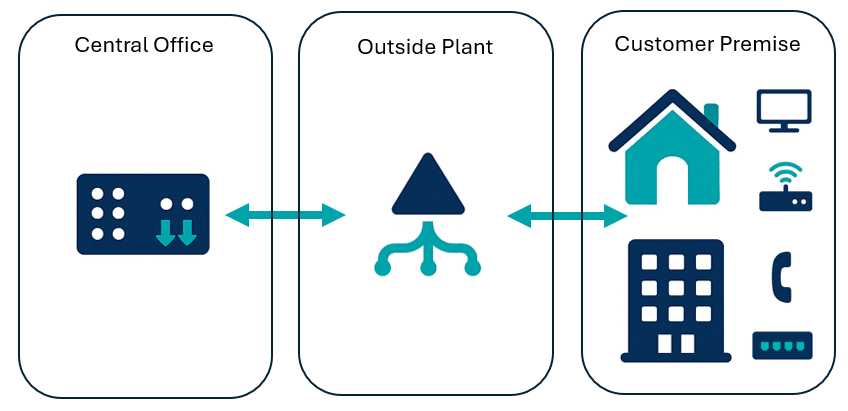
GPON vs. XG-PON vs. XGS-PON: Which PON Technology Is Right for Your Network?
Currently, Passive Optical Network (PON) technology has become one of the mainstream technologies for Fiber-to-the-X (FTTx) network construction. GPON technology is widely adopted due to its cost-effective deployment of high-bandwidth services, including broadband internet, IP telephony, and digital television. As user demand for high bandwidth continues to grow, GPON is gradually evolving towards 10G GPON, which includes XG PON and XGS PON.
Typical GPON Network:

The Basics of 10G GPON
“10G GPON” refers to 10G Gigabit Passive Optical Network, which is an advanced fiber-optic communication technology designed to provide higher data rates compared to traditional Passive Optical Network (PON) technologies like GPON (Gigabit PON). 10G GPON has several main variants, namely XG PON and XGS PON, which are slightly different in speed, symmetry and applications.
What Is XG-PON?
XG PON, short for 10-Gigabit Passive Optical Network, aims to provide higher transmission rates and longer transmission distances. Compared to GPON, XG PON supports downstream speeds of up to 10 Gbps (gigabits per second) and upstream speeds of up to 2.5 Gbps, offering users greater bandwidth support. It can be seen that XG PON is an asymmetric 10G GPON, providing asymmetric transmission rates.
The applications of XG PON include but are not limited to:
Broadband Internet Services: It can provide high-speed broadband internet connections for residential and business users, meeting the demands of bandwidth-intensive applications such as high-definition video streaming, large-capacity data downloads and uploads, and online gaming.
Back-to-Back Deployment: Due to the high transmission speed of XG PON, it can be used in enterprise and data center environments to connect different floors or buildings.
Multimedia Content Distribution: It can provide users with sufficient bandwidth to support increased consumption of multimedia content, such as online video on demand and cloud services.
The design of XG PON addresses some limitations of the previous generation technology, supporting more users, longer transmission distances, and stronger Quality of Service (QoS) guarantees. As media content and data volume continue to grow, XG PON is becoming a key technology to meet future broadband demands. With ongoing technological advancements, subsequent higher-speed PON variants such as XGS PON have emerged, further enhancing network performance and capacity.
What Is XGS-PON?
XGS-PON, or 10-Gigabit Symmetric Passive Optical Network, supports downstream and upstream speeds of up to 10 Gbps (gigabits per second). Unlike other PON technologies, XGS PON is symmetric, meaning that the downstream and upstream speeds are the same. By providing a symmetric 10 Gbps transmission rate, XGS PON technology is better suited for applications that demand high symmetrical bandwidth, such as high-quality video conferencing, cloud computing, and more. The application of multi-wavelength technology is also a significant innovation of XGS PON. This technology allows the simultaneous use of multiple wavelengths, enabling wavelength division multiplexing on the fiber and enhancing network capacity and flexibility.
Its application scenarios include, but are not limited to:
Enterprise Connectivity and Data Center Interconnection: Enterprises often require high-speed internet to support their online operations, including big data analytics, cloud computing, remote storage/backup solutions, and more.
Mobile Backhaul and Fronthaul: With the rollout of 5G technology, mobile operators need higher-speed connections to support data transmission between base stations and the core network.
Smart Cities and Internet of Things (IoT): Smart city applications, such as smart grids, traffic monitoring, and public safety systems, often require substantial data uploads, necessitating a symmetric high-speed connection.
GPON vs. XG-PON vs. XGS-PON, What’s the Difference?
GPON, XG-PON, and XGS-PON are different generations of passive optical network technologies.
The table below provides a comparison of their key parameters:
| Specification | GPON | XG-PON | XGS-PON |
| Downstream Speed | 2.5 Gbps | 10 Gbps | 10 Gbps |
| Upstream Speed | 1.25 Gbps | 2.5 Gbps | 10 Gbps |
| Symmetry | Asymmetric | Asymmetric | Symmetric |
| ITU Standards | G.984.x | G.987 | G.9807.1 |
| Center Wavelength | Downstream: 1490nm | Downstream: 1577nm | Downstream: 1577nm |
| Upstream: 1310nm | Upstream: 1270nm | Upstream:1270nm |






















